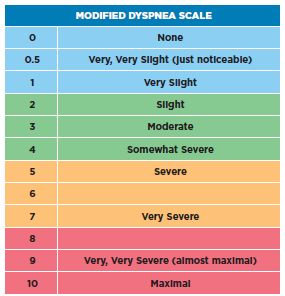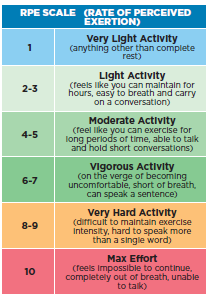Speaker 1: The material contained in this video presentation provides general information on the management of chronic obstructive pulmonary disease. This information is for reference purposes only and should not be considered medical advice. Before beginning or modifying any exercise program, please consult your medical provider to ensure that the activities demonstrated in this video presentation are appropriate for your specific health condition.
Janice Smeigh: Hi, I'm Janice Smeigh. I'm a doctor of physical therapy, and I'm going to talk to you about breathing easy with exercise.
Some of the objectives we're going to discuss today is understanding the equipment required for monitoring before and after exercise, knowing the energy conservation techniques and when to exercise, learning the American College of Sports Medicine guidelines, or ACSM guidelines, understanding and utilizing the RPE scale, discover the anatomy for breathing, understand proper breathing posture, and become skilled at diaphragmatic breathing with exercise.
Some of the disclaimers we'd like to discuss is that you should always seek medical clearance from your doctor prior to starting an exercise program. Take all medications and oxygen as prescribed. Use an assistive device as needed. If you feel faint during exercise, please stop and rest. If it's a medical emergency, please call 911.
Some of the equipment we use to monitor is a pulse oximeter, and we use this to check your oxygen content during and before exercise and usually throughout the day. The oxygen content should be between 88 to 100%. If it's below 88, we will do some diaphragmatic breathing, which we will talk about in a little bit. Some of the other equipment we may use during exercise is a watch or a timer, and that is to take your pulse. You can find your pulse by going right on the outside of your windpipe, close to your chin, your jaw line, and make sure that you don't push too hard or occlude both sides at the same time. You can count for an entire minute, or for 15 seconds and multiply by four. You can also find it on your wrist. You go right towards your thumb and if you palpate with both your index and your middle finger, you'll be able to count the beats per minute. Again, do not press down hard.
The other piece of equipment we're going to discuss is the blood pressure cuff. This is just an example of a wrist one. Just make sure you read your instructions prior to taking it, because some want you to look at the watch and some want you to bring it closer towards your heart. Normal heart rate and blood pressure should be around 75 for pulse beats per minute, and for blood pressure, it should be under 190 for the top number and the bottom number, or diastolic number, should be below 90 for exercising.
Energy conservation techniques is scheduling when you're going to do your exercise or when you're going to get done the activities that you need during the day. Always schedule your most important tasks in the morning, such as doctor's appointments or anything that you have to get done. This is when we're going to try and add our exercise in, on days you don't have important things to do.
We're going to discuss the FITT principle, which breaks down into frequency, intensity, time and type. Frequency, we want to do this most days of the week. For the aerobic exercise, we'd like to exercise three to four times a week and strength training two to three times a week. Intensity will be a three to six on that RPE scale. Sometimes we discuss the talk test. When you're exercising, you should be able to have a conversation with somebody that you're exercising with. Time should be at least 10 minutes at a time, up to 30 minutes, or 150 minutes per week. Type would be if you're doing a strength training or if you're doing an aerobic exercise.
The RPE scale is what we use to measure the intensity of your exercise. A zero would be resting, no discomfort or breathing troubles at all, and a 10 would be maximal and severe. During exercise, we'd like you between a three and a four, which is moderate to somewhat moderate, and progress to working out between a four and a six. Keep your O2 levels up to 88 to 90% at a minimum. Visual analog scale, or the VAS scale, can help us measure how short of breath you are. The smiley face is not short of breath at all and the frown face is very short of breath. You can just point to where you are during your workout.
Some of the muscles that help us breathe. During quiet breathing, when we breathe in, or inhale, the diaphragm helps along with the external intercostal muscles. When we breathe out, or exhale, we have a natural recoil of our ribs. During labored breathing, we use accessory muscles. During inhalations, we use the sternocleidomastoid, the serratus anterior, the pectoralis minor, and the scalenes. For expiration, we use the transverse thoracis and other abdominal muscles, along with the internal intercostal muscles.
We're going to discuss posture and what poor posture can do for your breathing and what good posture can do for your breathing. With poor posture, we have a forward head rounded shoulders, you can see my back is starting to curve and my bottom sticks out a little bit. Now I'm not going to be able to use my abdominals to exhale my diaphragm correctly and my lungs will not inhale and exhale or move as I need them during this poor posture. What we really want to work on is coming up nice and tall, creating the curvature in the back and bringing your neck back and up. A lot of times in our posture, when we're looking at the computer or walking, we tend to bring our chin up, which changes all the muscles in the front, the accessory muscles, how we're going to use them. Standing up nice and tall, and as I always say, keep the crown on top of your head and do not let it tip forward or backwards, that will help us with our breathing techniques.
Now we're going to discuss diaphragmatic breathing. The diaphragm completes about 75% of the work of breathing. What we're going to do is that we're going to put one hand on your chest and one hand on your belly. The chest hand should come up second. We're going to take a deep breath in our nose, or smell the roses, and then we're going to blow out the candles with our lips pursed together. This is important when we're exercising because it will help you to become less short of breath and use these accessory muscles.
We're going to talk a little bit more about skilled breathing. We're going to sit up nice and tall on their sit bones, we're going to put one hand on our chest and one hand on our stomach. We're going to inhale, and then we're going to exhale twice as long as we've inhaled. Okay, this should be eight to 10 reps per minute. It's important to get this down prior to moving onto our exercise skillsets.
To advance your skilled breathing, what you can do is you can go into a semi-reclined position and practice your breathing there. Afterward, you can lie down. This is going to be more difficult because we have gravity pressing onto our chest, thus making it more difficult to breathe. We can expect many benefits from exercising. It can improve your sleep, fatigue, strength, decrease your anxiety, and help you lose weight.
Thank you.


